The Bailiwick of Jersey is a British crown dependency that lies just off the coast of France. The island exhibits a rich mixture of both French and English culture and is a popular getaway destination for many Brits. Despite being in a currency union with the UK, there are still slight differences in their coins.
In this guide, we’ll break down the Jersey Pound and walk you through the most common Bailiwick of Jersey coins. Let’s get right into it to see which Jersey coins are worth anything.
What is the Jersey Pound?
The Bailiwick of Jersey is in a currency union with the rest of the United Kingdom and therefore uses the pound sterling. The difference comes in the fact that the State of Jersey issues their own banknotes and coins which have come to be known as the Jersey Pound.
The Jersey Pound is considered the official legal tender of Jersey but notes from the Bank of England, the Guernsey Pound and Scottish banknotes are all legal tender on the Island as well. You’ll also find that Euros are accepted in some parts of the Island, but this isn’t applicable everywhere.
Despite this, the Jersey Pound is not legal tender anywhere within the United Kingdom (similar to the Guernsey Pound) and so returning visitors from Jersey must exchange any spare Jersey currency.
The differences between the banknotes for the Jersey Pound and those issued by the Bank of England are quite clear. However, this is not the case for the Bailiwick of Jersey coins, which look very similar to those found within the UK.
This means that you may come across a Jersey coin in your change occasionally as they frequently go unnoticed by those handling them.
If you discover a Jersey coin in your change in the UK it makes sense to hold onto it, as they are worth more as collectable items than to spend at face value in a shop.
The Bailiwick of Jersey Coins
Now you know a little bit about the history of the Jersey Pound, we’ll break down each of the coins you can expect to find in your change, their designs and values where possible.
Please bear in mind that we have included average values over the particular years of a design’s mintage, which means that individual values will vary.
Bailiwick of Jersey Half Penny
1971 and 1980 New Half Penny
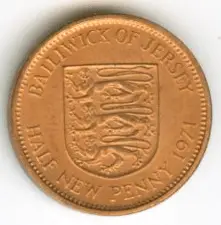
The Bailiwick of Jersey half penny was first minted in 1971 and afterwards in 1980 with the inscription ‘HALF NEW PENNY’. It was not until 1981 that the ‘NEW’ inscription was removed.
The mintage for the 1971 edition was 4,000,000 while the 1980 edition was significantly lower with a mintage of just 200,000. There was also a proof version issued in 1980 which had an even smaller mintage of 10,000.
1981 Half Penny
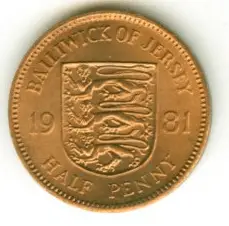
The Jersey half penny was only minted in one year – 1981 – without the ‘NEW’ inscription. The mintage for this year was 50,000.
There was also a proof set issued by the Birmingham Mint which had a limited release of just 6,000.
Bailiwick of Jersey 1p Coin
1971 and 1980 New One Penny
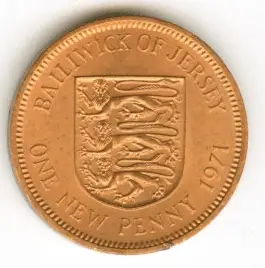
The Jersey new one pennies were minted in 1971 and 1980 with mintages of 4,000,000 and 3,500,000 respectively. The reverse design of these coins features the Coat of Arms of Jersey with the inscription ‘ONE NEW PENNY’ as was the case following decimalisation.
You can expect to pay around £0.50 for either of these coins, depending on grade.
1981 Coat of Arms

In 1981 the Jersey one penny was revamped with the inscription ‘ONE PENNY’ without the ‘NEW’ as before, as well as the year inscription on either side of the Coat of Arms design.
This particular coin had a mintage of 50,000 which is very small. It was also issued in the same proof set as the 1981 half penny, which saw an extra 6,000 coins issued.
A 1981 Jersey penny is valued at around £1 to £2, depending on grading.
Le Hocq Watch Tower (1983-2016)
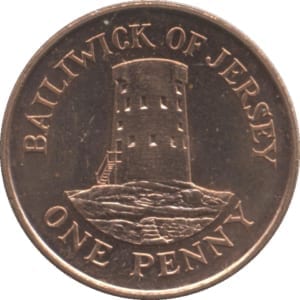
The Bailiwick of Jersey 1p coin featuring the Le Hocq Watch Tower was first minted in 1983 until 2016, with the obverse design changing in 1998 from the portrait of Her Majesty the Queen designed by Raphael Maklouf to the portrait designed by Ian Rank Broadley.
The reverse features Le Hocq Tower which sits on the south coast at Saint Clement’s Bay and is one of the most iconic landmarks in Jersey. The tower was built in the 1780s to protect the island from French invasions and still stands to this day.
A circulated Jersey 1p coin of this era in good condition can fetch anywhere up to £1 on eBay and listings for the coin appear frequently, however, the value can vary greatly depending on what year coin you have.
Bailiwick of Jersey 2p Coin
New Two Pence (1971, 1975 and 1980)
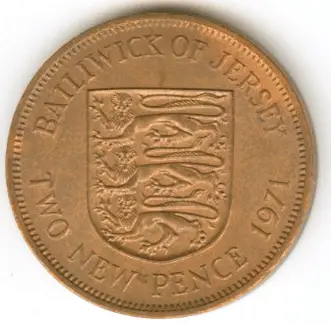
The Jersey New Two Pence was minted in the years 1971, 1975 and 1980 with mintages of 2,225,000, 3,250,000 and 2,030,000 respectively. The reverse design is identical to the new one pence design with the inscription ‘NEW TWO PENCE’.
Examples sell for around £0.50 to £1, but this varies greatly depending on grade.
1981 Two Pence
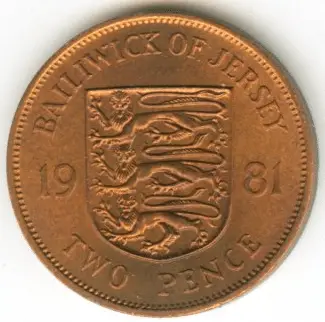
In 1981 the ‘NEW’ inscription was removed and the design remained the same, the mintage for this year was 1,050,000; split into 50,000 in 1981 and the remaining 1,000,000 in 1982.
Examples of these coins sell for £1 to £2, depending on grade and who you are selling to.
As before, the 1981 issue was also produced in a proof set with a mintage of 6,000.
St Helier (1983-2016)
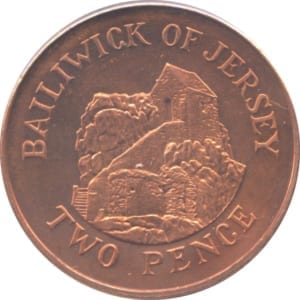
The St. Helier Jersey 2p coin was issued between 1983 and 2016. As with the 1 pence coin, the 2 pence had the same reverse design from 1983 until 2016, whereas the obverse portrait changed in 1998.
The reverse design shows the Hermitage of St. Helier, a rocky tidal island that is connected to the capital of Jersey by a breakwater. The design focuses mainly on the small chapel that can be found on the Hermitage which attracts many visitors every day despite its damp appearance.
As with the 1p coin, these coins regularly fetch up to £1 on eBay thanks to their relatively low mintage.
Bailiwick of Jersey 5p
1968 and 1980 Five New Pence
In 1968 the first five pence coin was issued in Jersey following decimalisation.
Originally 3,600,000 of these coins were issued, but 1,200,000 were returned for scrap a few years after leaving 2,400,000 in circulation. It wasn’t until 1980 that another five pence was issued, also with the inscription of ‘Five New Pence’, which had a much smaller mintage of 800,000.
In 1990 these coins ceased to be legal tender, along with the other 5p coins issued before 1990 including the 1981 new pence and the Seymour Tower 5p coins issued before this date.
Jersey’s new 5-pence pieces regularly sell for between £0.20 and £1.00.
1981 Five Pence
Following a similar theme to the denominations below it, the 5 pence piece was issued in 1981 with the removal of the ‘NEW’ inscription.
This coin had a mintage of 50,000 alongside the 6,000 proof specimens in the set issued by the Birmingham Mint and can be found for upwards of £1.00 in some cases.
Seymour Tower (1983-2016)
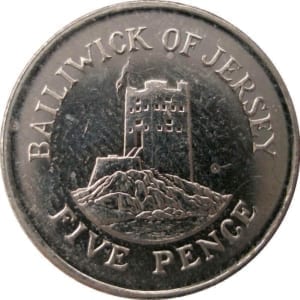
Seymour Tower
The reverse design of the Bailiwick of Jersey 5p coin features another of the island’s iconic defence towers. Seymour Tower was built on the rocky tidal island of L’Avarison in 1782 following the Battle of Jersey.
The tower is completely surrounded by water twice a day as the tide comes in and as of 2006, it can be rented out as self-catering accommodation for those looking to experience Jersey in a unique way.
Despite the lower resell value compared to the 1p and 2p coins, there is still demand out there for the Jersey 5p coin and they are frequently sold on eBay for around £0.50.
Bailiwick of Jersey 10p Coin
New Ten Pence (1968, 1975 and 1980)
The first ten pence introduced to Jersey was the 1968 new ten pence which had a mintage of 1,500,000; with 1 million of those produced in 1969 and the remainder in 1970.
Following this, there was the 1975 issue with a mintage of 300,000 in 1975 and a further 722,000 in 1979 to make 1,033,000 in total.
The last of the Jersey 10 pence pieces came in 1980 and these had a mintage of 1,000,000. All of these coins sell for between £0.50 and £2.00, depending on grading.
1981 Ten Pence
50,000 1981 ten pence coins were produced with the ‘NEW’ inscription removed.
Like the other coins in 1981, it also had 6,000 proof versions issued as part of the set. These are more valuable, and sell for £1 to £3.
Faldouet Dolmen Design (1983-2016)
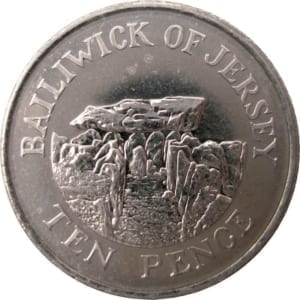
The Bailiwick of Jersey 10p coin features an interesting landmark that can be found in St. Martin on its reverse design.
The Faldouet Dolmen is a passage grave, originally built around 6000 years ago. The grave consists of multiple stone chambers and human remains have been found there during excavations.
The Faldouet Dolmen has free access to the general public although visitors are of course asked to be respectful.
Out of all the lower value coins, the Jersey 10p has the biggest fluctuation in sell price with recent eBay listings ranging from 15p to just over a pound.
Bailiwick of Jersey 20p Coin
Lighthouse Design (1982)
Featuring what is perhaps the most famous of Jersey’s landmarks is the Bailiwick of Jersey 20p coin. The Lighthouse of La Corbiere can be found proudly displayed on the coin’s reverse design.
La Corbiere’s striking blue waters and rocky coast draws in thousands of tourists from around the world each year. Nearly all promotional images of the town feature the iconic white lighthouse in some way and its dramatic positioning on the coast makes it clear to see why.
There were no 20p coins dated between decimalisation and 1981, and in 1982 the first Jersey 20p was issued with a mintage of 600,000. This was in commemoration of the 100th Anniversary of the Lighthouse, and this coin sells for a few pounds typically.
Lighthouse Design (1983-2016)
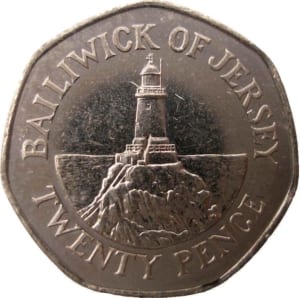
The 1983-2016 Jersey 20p coins are relatively sought after by collectors thanks to the low mintage compared to similar UK coins. Listings crop up on eBay every day and the coins are regularly sold for around £1.50 to £2.00.
Bailiwick of Jersey 50p Coin
New Fifty Pence (1969 and 1980)
The first 50p coins issued in Jersey were given the inscription ‘New Fifty Pence’ due to decimalisation and were issued in the years 1969 and 1980.
The mintages for these years were 480,000 and 100,000 respectively and you can find examples online for a couple of pounds.
Fifty Pence 1981
50,000 fifty pence pieces were produced in 1981 alongside 6,000 in proof standard for the set.
These are much more scarce than the ‘new’ fifty pence pieces before and are worth anywhere from a few pounds to £10, with the proof variations worth more.
Castle Design Fifty Pence (1983 – 2016)

Just like the Bank of England, the Jersey State releases commemorative 50p coins that feature designs relevant to the island’s history.
For the purpose of this article, we’ll focus on the ‘original’ design which displays the ruins of Grosnez Castle in St Ouen. The castle was built in the 14th century and held against the French during invasions before eventually becoming ruins in the 16th century.
This original design of the Jersey 50p coin sells for around £1.25 on eBay but prices soon begin to increase if you’re lucky enough to find one of the commemorative versions of the coin.
40th Anniversary of Liberation Fifty Pence (1985)
Another commemorative Jersey 50p is the 1985 Anniversary of Liberation 50p, which had a mintage of 65,000.
This coin commemorated 40 years since the Liberation of Jersey during the end of World War 2 and features a pair of crossing flags on the reverse design.
Examples of this coin regularly sell for between £5 and £20.
Bailiwick of Jersey £1 Coin
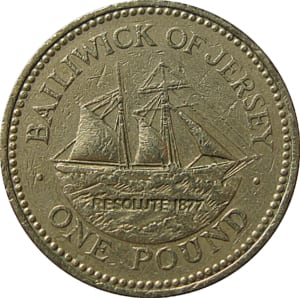
The Bailiwick of Jersey £1 coin is another coin that has several commemorative issues from the State of Jersey.
Recent coins have featured different boats in varying sail positions but the coin you’ll most frequently find has the Schooner in a sail right position. The schooner is an iconic boat that was commonly used for trading in and out of Jersey’s harbours.
The several versions of the Jersey £1 coin make it difficult to estimate the resell price on eBay but for this particular version, it appears the value is around £1.70. Other rarer versions of the coin can sell for up to £5.
Bailiwick of Jersey £2 Coin
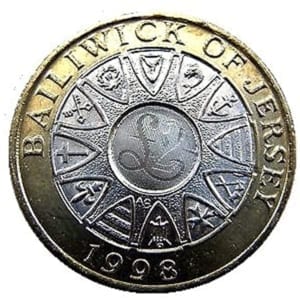
The reverse design of the Bailiwick of Jersey £2 coin represents Jersey’s history in the best possible way. The design features the crest of each of the 12 parishes of Jersey, connected by a central star design.
Despite being a small island with a relatively low population, each parish has its own unique sense of community and pride. The £2 coin represents the mutual respect for each of the individual parishes and bonds them together on the most valuable coin in legal tender.
The Jersey £2 coin is one of the most sought-after coins to come out of the island. The coin regularly fetches around £5 on eBay although some previous listings have fetched as much as £10.
FAQs
Did Jersey Have A Different Currency Before The Pound?
The Jersey pound has not always been the currency used in Jersey.
Between 1729 and 1834 the Jersey Livre was used. This was French currency and was divided into 20 sous which were each worth 12 deniers.
Without getting into it too much, the French currency was eventually replaced by the pound sterling in 1934.
Where Can You Exchange Old Jersey Pounds?
Since the Jersey Pound is not legal tender in the UK, the best option for exchanging old Jersey pound coins is to hand them to your local bank or post office.
Final Thoughts
The Bailiwick of Jersey may only be a small island but their coins come with a lot of value to UK collectors. If you ever plan a trip there, or if you’re lucky enough to get a Jersey coin in your regular change, you could be in with a profit.
Credit for mintage figures and some images go to this archive – definitely worth a read!
